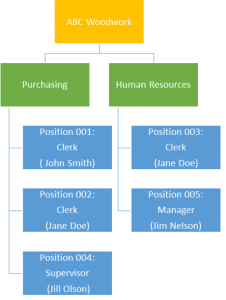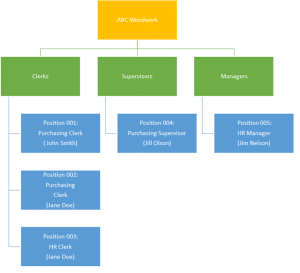Organizational Structure within Microsoft Dynamics AX Human Resource Management
Formal organizational structures are used to organize workers, in such a way as to support and promote company objectives. There are many models for organizational structures, however, most models will be designed to:
- Facilitate company communication
- Define company policies
- Clearly communicate roles and responsibilities
- Define lines of authority
Organizational structures are tracked in Microsoft Dynamics AX HR through the use of three organizational elements: departments, jobs and positions.
Departments are operating units that represent categories or functional areas of the business. Each department is responsible for a specific area of the organization.
Job definitions within AX are an accumulation of the responsibility and competency characteristics of a worker’s employment relationship – which tasks the worker will be performing, and the competencies required of the worker holding the position. What the worker will be doing is tracked through Job Functions, Job Tasks and Areas of Responsibility. Competencies required of the worker are tracked through Skills, Certificates, Tests, Education and Screenings. Jobs maintain a many-to-one relationship with positions - each job may be assigned to more than one position, but each position can be assigned to only one job.
Positions are used to define the relationship between a worker and the company. Each position can be assigned to only one worker, but each worker can be assigned to multiple positions. Each position in AX represents one instance of a job, and can be assigned to a department. Position definitions include the logistical characteristics of the worker’s employment relationship with the organization: the department assignment, the compensation region, and to whom the worker reports.
Workers cannot be paid in AX without a position assignment, hence, any company intending to use AX for payroll will need to define at least one job for the entire company, and at least one position for each worker.
I’ve included an example below, meant to graphically demonstrate this concept using a portion of ABC Woodwork’s organization structure. In this example, I’ve included the Purchasing and Human Resources departments, which represent functional areas within the ABC Woodwork. Clerk, Supervisor, and Manager represent jobs as defined by ABC Woodwork. These jobs represent groupings of common responsibilities, tasks and competencies, regardless of which department in which the job is performed. The positions each represent an employment relationship with an employee, defining what the employee is responsible for (the job) and where (department) the employee will be performing their duties. Two of the clerk positions are part-time, and held by the same employee.
The two graphics represent the same organizational design, but from different perspectives. The first graphic is meant to detail all of the positions in each department. The second graphic presents the organization from the perspective of the job, grouping the Clerks, Supervisors, and Managers together.
[caption id="attachment_1520" align="aligncenter" width="226"]
[caption id="attachment_1521" align="aligncenter" width="300"]
Please note this blog is specifically for assistance in designing your organizational structure for the purposes of defining departments, jobs and positions. It is not meant to address Organizational Hierarchies in Microsoft Dynamics AX, which will be discussed in a later post.
For additional information regarding design of organizational structures with AX’s HR module, contact Stoneridge Software today.
Kristy Loeks
Under the terms of this license, you are authorized to share and redistribute the content across various mediums, subject to adherence to the specified conditions: you must provide proper attribution to Stoneridge as the original creator in a manner that does not imply their endorsement of your use, the material is to be utilized solely for non-commercial purposes, and alterations, modifications, or derivative works based on the original material are strictly prohibited.
Responsibility rests with the licensee to ensure that their use of the material does not violate any other rights.
